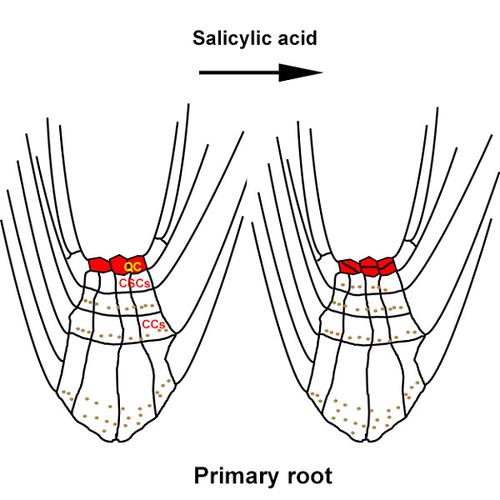当前位置:
X-MOL 学术
›
J. Integr. Plant Biol.
›
论文详情
Our official English website, www.x-mol.net, welcomes your
feedback! (Note: you will need to create a separate account there.)
Salicylic acid promotes quiescent center cell division through ROS accumulation and down‐regulation of PLT1, PLT2, and WOX5
Journal of Integrative Plant Biology ( IF 9.3 ) Pub Date : 2020-10-05 , DOI: 10.1111/jipb.13020 Zhuqing Wang 1, 2 , Duoyan Rong 2, 3 , Dixing Chen 1, 2 , Yang Xiao 1, 2 , Renyi Liu 2, 4 , Shuang Wu 2 , Chizuko Yamamuro 2
Journal of Integrative Plant Biology ( IF 9.3 ) Pub Date : 2020-10-05 , DOI: 10.1111/jipb.13020 Zhuqing Wang 1, 2 , Duoyan Rong 2, 3 , Dixing Chen 1, 2 , Yang Xiao 1, 2 , Renyi Liu 2, 4 , Shuang Wu 2 , Chizuko Yamamuro 2
Affiliation

|
Salicylic acid (SA) plays a crucial role in plant immunity. However, its function in plant development is poorly understood. The quiescent center (QC), which maintains columella stem cells (CSCs) in the root apical meristem and typically exhibits low levels of cell division, is critical for root growth and development. Here, we show that the Arabidopsis thaliana SA overaccumulation mutant constitutively activated cell death 1 (cad1), which exhibits increased cell division in the QC, is rescued by additional mutations in genes encoding the SA biosynthetic enzyme SALICYLIC ACID INDUCTION DEFFICIENT2 (SID2) or the SA receptor NONEXPRESSER OF PR GENES1 (NPR1), indicating that QC cell division in the cad1 mutant is promoted by the NPR1‐dependent SA signaling pathway. The application of exogenous SA also promoted QC cell division in wild‐type plants in a dose‐dependent manner and largely suppressed the expression of genes involved in QC maintenance, including those encoding the APETALA2 (AP2) transcription factors PLETHORA1 (PLT1) and PLT2, as well as the homeodomain transcription factor WUSCHEL‐RELATED HOMEOBOX5 (WOX5). Moreover, we showed that SA promotes reactive oxygen species (ROS) production, which is necessary for the QC cell division phenotype in the cad1 mutant. These results provide insight into the function of SA in QC maintenance.
中文翻译:

水杨酸通过ROS积累和下调PLT1,PLT2和WOX5促进静息中心细胞分裂
水杨酸(SA)在植物免疫中起着至关重要的作用。但是,人们对其在植物发育中的功能了解甚少。静态中心(QC)在根尖分生组织中保持小肠干细胞(CSC),并且通常显示出低水平的细胞分裂,对于根的生长和发育至关重要。在这里,我们显示拟南芥SA过度积累突变型组成性激活细胞死亡1(cad1),其在QC中表现出增加的细胞分裂,是由编码SA生物合成酶SALICYLIC ACID INDUCTION DEFFICIENT2(SID2)或PR GENES1(NPR1),OF SA受体NONEXPRESSER指示在该QC细胞分裂CAD1NPR1依赖性SA信号转导通路促进了该突变体的产生。外源SA的应用还以剂量依赖的方式促进了野生型植物的QC细胞分裂,并大大抑制了QC维持相关基因的表达,包括编码APETALA2(AP2)转录因子PLETHORA1(PLT1)和PLT2的基因,以及同源域转录因子WUSCHEL-RELATED HOMEOBOX5(WOX5)。此外,我们表明SA促进了活性氧(ROS)的产生,这对于cad1突变体中QC细胞分裂表型是必需的。这些结果提供了对SA在QC维护中的功能的了解。
更新日期:2020-10-05
中文翻译:

水杨酸通过ROS积累和下调PLT1,PLT2和WOX5促进静息中心细胞分裂
水杨酸(SA)在植物免疫中起着至关重要的作用。但是,人们对其在植物发育中的功能了解甚少。静态中心(QC)在根尖分生组织中保持小肠干细胞(CSC),并且通常显示出低水平的细胞分裂,对于根的生长和发育至关重要。在这里,我们显示拟南芥SA过度积累突变型组成性激活细胞死亡1(cad1),其在QC中表现出增加的细胞分裂,是由编码SA生物合成酶SALICYLIC ACID INDUCTION DEFFICIENT2(SID2)或PR GENES1(NPR1),OF SA受体NONEXPRESSER指示在该QC细胞分裂CAD1NPR1依赖性SA信号转导通路促进了该突变体的产生。外源SA的应用还以剂量依赖的方式促进了野生型植物的QC细胞分裂,并大大抑制了QC维持相关基因的表达,包括编码APETALA2(AP2)转录因子PLETHORA1(PLT1)和PLT2的基因,以及同源域转录因子WUSCHEL-RELATED HOMEOBOX5(WOX5)。此外,我们表明SA促进了活性氧(ROS)的产生,这对于cad1突变体中QC细胞分裂表型是必需的。这些结果提供了对SA在QC维护中的功能的了解。









































 京公网安备 11010802027423号
京公网安备 11010802027423号